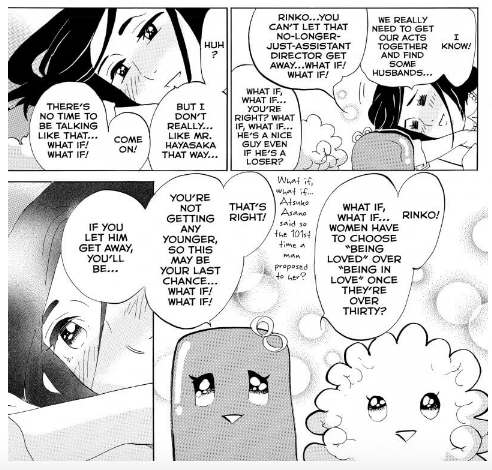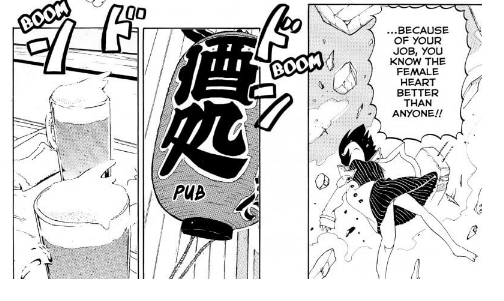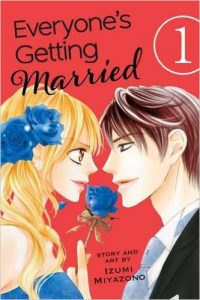I still very much enjoy Everyone’s Getting Married, but this volume was a little bit of a letdown, mostly because I’m not terribly fond of the way the “suddenly a rival appears!” storyline is being executed.
At the end of the last volume Kamiya, a work colleague of Asuka’s decided that she would be his ideal wife. He was not put off by the fact that she’s dating Ryu, and Kamiya’s persistence was one of the most annoying things about this volume, even though he did bring up some good and rational points about Asuka and Ryu’s counterproductive relationship. Asuka is mostly reduced to a bargaining chip between the men, and her actions are a little bit too passive, although I suppose it is an accurate portrayal of where a woman might end up when she has been thoroughly socialized to be nice all the time. The volume opens with Ryu and Kamiya getting a drink together, and even though Ryu warns Kamiya to stop his pursuit of Asuka, Kamiya is undeterred, pointing out the futility of a relationship where one person wants to get married and the other is set against it. Kamiya is convinced that the couple will eventually break up, and when that happens he will be there, ready to scoop up Asuka and take advantage of her innate intelligence and competence to have the supportive live partner of his dreams.
Kamiya proceeds to both threaten and manipulate Asuka into spending time with him, and I started feeling very annoyed that Asuka was so passive that she got thrown into situations with Kamiya when she didn’t really want to spend time with him. Ryu and Asuka always do reaffirm their relationship, and a brief trip away with a break from work serves to smooth things over. One of the reasons why this manga is so interesting to read is the fact that either one of the main characters is going to have to fundamentally change, or they will have to break up, and that dramatic tension is intriguing. This volume felt like a bit more of a placeholder, and I hope there’s a more satisfying story in the next volume.






 Despite that tragedy, I gaze fondly back at 2013, as the year that brought me new favorites like
Despite that tragedy, I gaze fondly back at 2013, as the year that brought me new favorites like  SEAN: There was a lot of great manga released in 2013, even if you just stick with titles that began this year. My mind keeps drifting over to one title in particular, and that’s the deluxe hardcover release of
SEAN: There was a lot of great manga released in 2013, even if you just stick with titles that began this year. My mind keeps drifting over to one title in particular, and that’s the deluxe hardcover release of  MICHELLE: I am finding this profoundly difficult. I picked Taiyo Matsumoto’s Sunny for our
MICHELLE: I am finding this profoundly difficult. I picked Taiyo Matsumoto’s Sunny for our  ASH: Oh, this really is difficult! I always have a hard time choosing bests or favorites, but I did recently manage to write about some of the manga from the last year that were
ASH: Oh, this really is difficult! I always have a hard time choosing bests or favorites, but I did recently manage to write about some of the manga from the last year that were 















